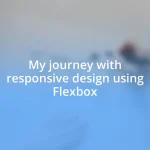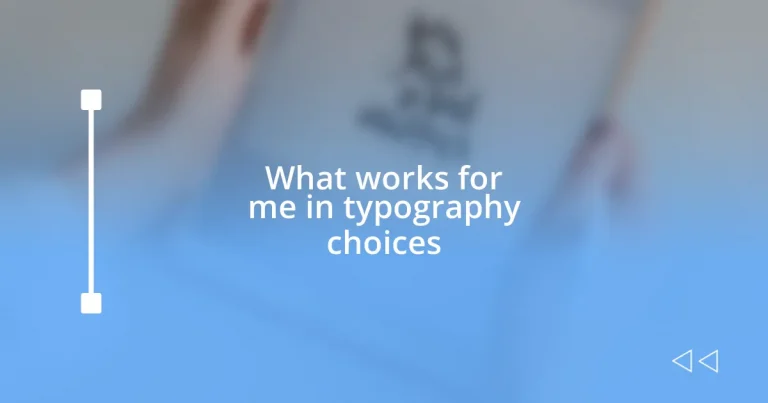Key takeaways:
- Typography enhances readability and visual appeal; bold sans-serif fonts convey modernity, while delicate serif fonts suggest elegance.
- Selecting the right font impacts message perception, requiring consideration of readability, brand identity, and audience expectations.
- Best practices for text readability include appropriate font size, adequate line spacing, and high color contrast to prevent user frustration.
- White space is crucial for clarity and emotional impact, guiding readers’ attention and improving overall engagement with the design.
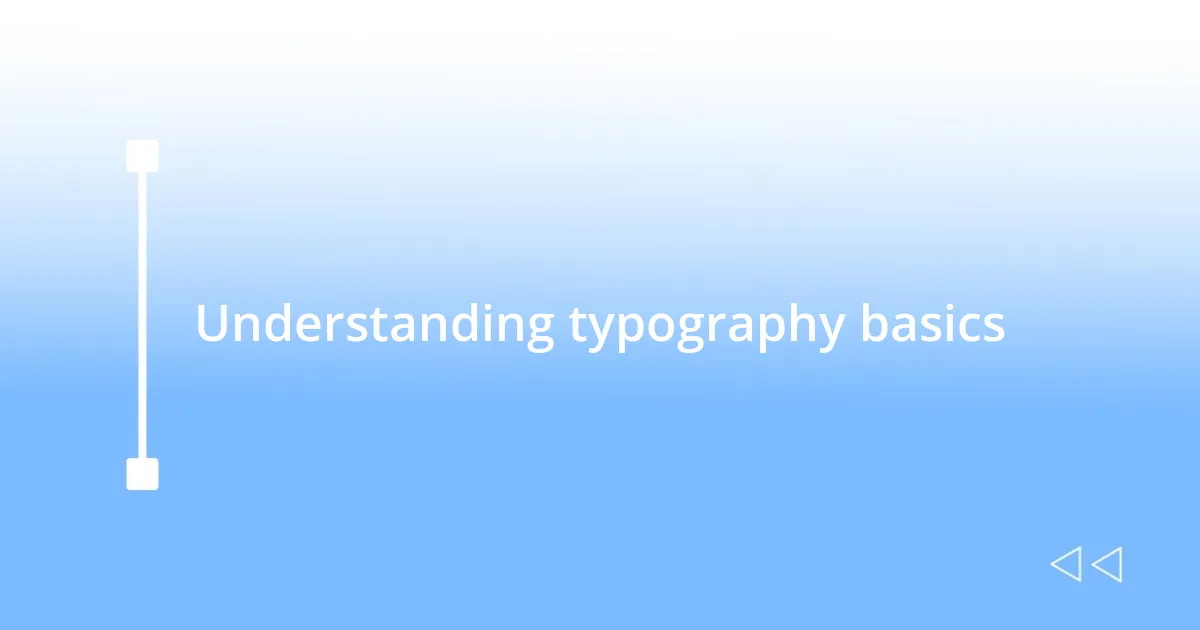
Understanding typography basics
Typography, at its core, is the art of arranging text in a way that enhances both readability and visual appeal. I remember the first time I designed my own flyer; I spent hours experimenting with different fonts and sizes, realizing how a simple font choice could evoke completely different feelings. Have you ever noticed how a bold, sans-serif font can feel modern and energetic, while a delicate serif font might exude elegance and tradition?
The anatomy of a typeface—comprising elements like baseline, x-height, and serifs—may sound technical, but understanding these basics is crucial. Each component plays a pivotal role in the text’s overall feel. For instance, when I worked on a personal project, adjusting the x-height immediately transformed the text’s legibility, making it more engaging for my audience. Have you ever adjusted your font just to see how little tweaks can lead to such a dramatic shift in a design’s effectiveness?
Choosing the right typography goes beyond aesthetics; it’s about conveying the right message and emotion. In my experience, pairing contrasting typefaces can emphasize certain parts of the content beautifully. For example, using a playful script font alongside a clean, modern sans-serif creates a delightful contrast that draws the eye. Doesn’t it make you wonder how much typography influences our daily interactions with text?
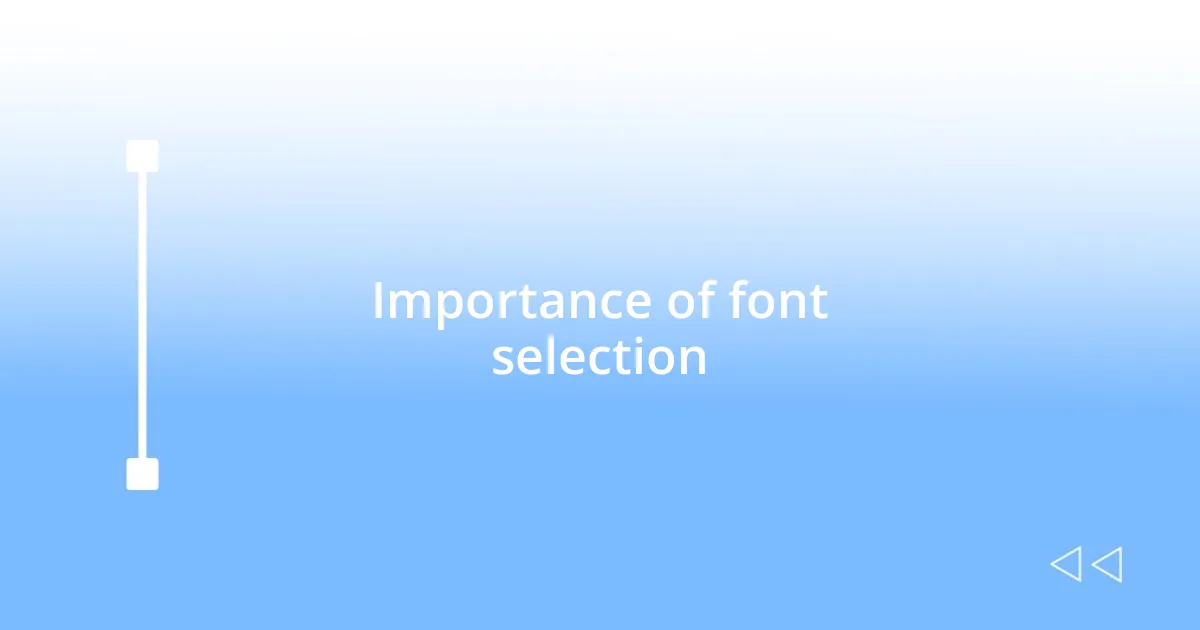
Importance of font selection
The selection of fonts carries significant weight in how messages are perceived. I vividly recall a project where I had to design a presentation for a community event. I initially opted for a playful comic font, thinking it would resonate with the audience. To my surprise, feedback indicated that it felt unprofessional. It was a powerful lesson in the importance of choosing a font that aligns with the content’s tone and the audience’s expectations.
Here are some factors to consider when selecting fonts:
– Readability: A legible font ensures your message is easily absorbed.
– Brand Identity: Different fonts convey different personalities; make sure your choice reflects your brand.
– Audience Engagement: The right font can connect with your audience emotionally, influencing their perception.
– Hierarchy and Emphasis: Using font size and style variations can lead the viewer through your content naturally.
– Cultural Sensitivity: Some fonts may carry different meanings or connotations in various cultures; this is something to be mindful of.
Each selection shapes the reader’s experience, and I believe that paying attention to these details can elevate the overall impact of any design.
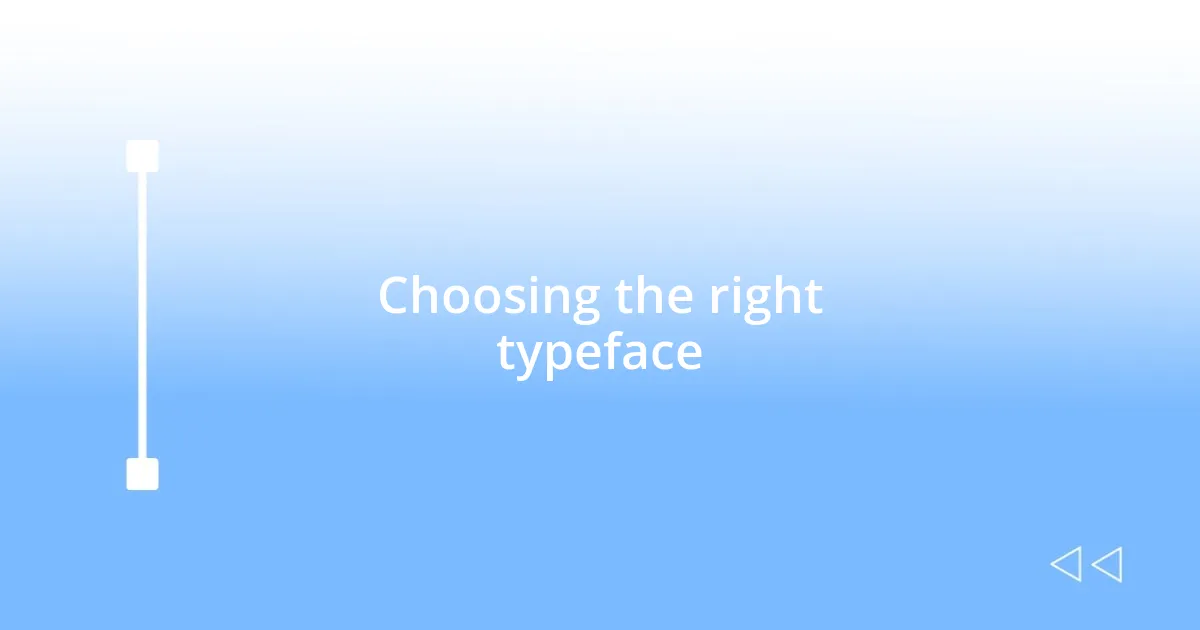
Choosing the right typeface
Choosing the right typeface can be a game-changer in any design project. I remember when I first attempted to create my website; I chose a trendy font that I thought looked cool. However, after a few weeks, I realized it was hard to read on mobile devices. That simple oversight taught me that usability must always take precedence—no one wants to struggle to read, right?
There’s a delicate balance between style and function in typography. When I was working on a book cover, I initially leaned towards a bold, decorative typeface. But after consulting with a few readers, I changed it to a more classic serif font. The final design not only looked more polished but also resonated more with the audience. Do you think your fonts reflect the message you want to convey?
It’s also vital to consider the context in which your typeface will be presented. For instance, when I chose a minimalist font for a tech blog, it created an inviting and modern atmosphere. Yet, when I used an ornate font for a historical piece, the results felt more authentic and relevant. It’s intriguing how much context influences the perception of your typography choices.
| Typeface | Usage Context |
|---|---|
| Sans-serif | Modern, clean designs |
| Serif | Traditional, formal content |
| Script | Creative, artistic projects |
| Display | Attention-grabbing headlines |

Best practices for text readability
When aiming for optimal text readability, one crucial aspect to focus on is font size. I remember struggling with a blog post because I used a size that looked good on my desktop but was nearly impossible to read on mobile devices. A good rule of thumb is keeping the body text between 16 and 18 points. It’s all about ensuring your content is approachable and can be easily consumed by anyone, wouldn’t you agree?
Line spacing, or leading, is another critical factor that often gets overlooked. I once worked on a newsletter where the lines were too cramped, making it difficult for readers to mentally transition from one line to the next. After increasing the spacing, the feedback was overwhelmingly positive—readers could finally breathe while reading! Finding a balance typically between 1.5 and 2 times the font size really enhances flow and comprehension.
Lastly, color contrast plays an essential role in enhancing readability. I made an unfortunate choice once using light gray text on a white background, thinking it gave a sleek look. Instead, it frustrated my audience, who struggled to read the content. Dark text on a light background, or vice versa, usually provides the best visibility. It raises an interesting question: how often do we evaluate our color choices in terms of their readability impact?

Combining fonts effectively
Combining fonts effectively can transform your design from mediocre to magnificent. I once mixed a sans-serif typeface for the body with a contrasting script font for headings in a wedding invitation. The result was not just visually appealing; it captured the joyous essence I wanted to convey. Have you ever noticed how the right combination can evoke specific emotions?
However, it’s vital to choose complementary fonts that enhance each other rather than clash. I remember a project where I paired an elegant serif with a bold sans-serif. At first, I thought it created a striking contrast, but upon reflection, it felt disjointed. Listening to feedback opened my eyes to how alignment and harmony in text choices foster a seamless reading experience. Could your current font combinations be sending mixed signals?
As I explore different design projects, I often consider the number of fonts I include. My rule of thumb is no more than three distinct fonts: one for headings, another for the body, and perhaps a third for accents. This approach keeps everything cohesive but still allows for a bit of creativity. What has your experience been with managing multiple typefaces in a single design? It’s fascinating how less can sometimes be more when it comes to typography.

The role of white space
White space, often overlooked, is a powerful design element that significantly impacts how content is perceived. I recall a project where I filled every inch of a flyer with text and images, thinking it would convey a wealth of information. Instead, it felt overwhelming and cluttered. When I finally decided to simplify the layout and introduce more white space, my message became clearer, and engagement skyrocketed. Have you ever experienced the relief of seeing your design breathe after adding space?
In my experience, white space actively guides the reader’s eye and creates a sense of organization. I worked on a website redesign where sections were tightly packed, and users often misinterpreted the content. By strategically adding margins and padding around elements, I noticed a dramatic improvement in user interaction. It’s remarkable how distance can foster clarity, isn’t it?
Moreover, the emotional component of white space cannot be underestimated. For instance, I once designed a poster for a charity event using ample white space to evoke serenity and openness. The audience resonated deeply with it, drawing them in as if they were welcomed into a peaceful environment. I often ask myself, how might white space amplify the emotional tone of your designs?
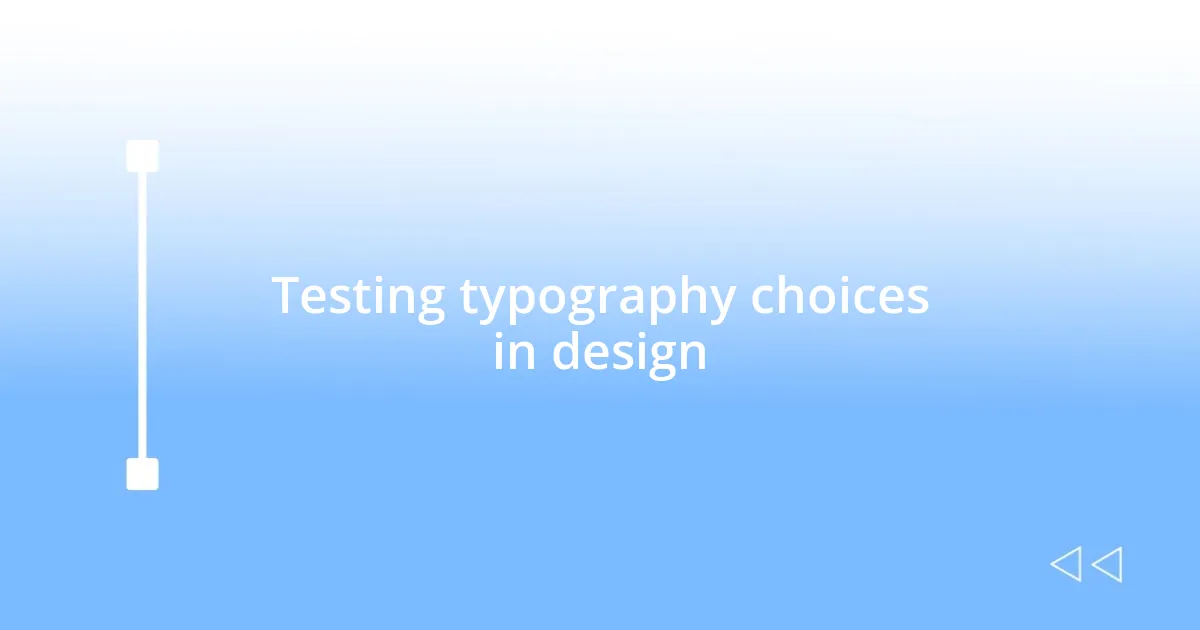
Testing typography choices in design
Testing typography choices in design is something I take quite seriously. In one project, I decided to experiment with different font weights and sizes on a web page. Initially, I went bold and used larger text for emphasis. However, after gathering user feedback, it became clear that the visual hierarchy felt off. Scaling back and testing various weights not only improved readability but also created a more intentional flow. How often do you evaluate the impact of weight and size on your design’s effectiveness?
To refine my typography choices, I often create mockups and gather feedback from peers or potential users. I vividly remember developing a logo where I tried to blend two entirely different styles—a heavy, blocky font with a delicate script. Through testing, I found that while both fonts were striking individually, they conflicted when combined. The audience’s reaction solidified my understanding that typography shouldn’t just look good; it should convey a cohesive message and resonate with the audience. Ever found yourself torn between aesthetics and readability?
Another technique I apply is A/B testing to see how different typography can affect engagement. I recall redesigning the call-to-action on a landing page, where I tested a bold serif font against a clean sans-serif. The results surprised me—the sans-serif version not only matched the brand’s voice better, but it also significantly boosted conversion rates. It’s fascinating to consider how the subtle nuances of typography can influence behavior. Have you ever thought about how small changes in type can create big shifts in user perception?









